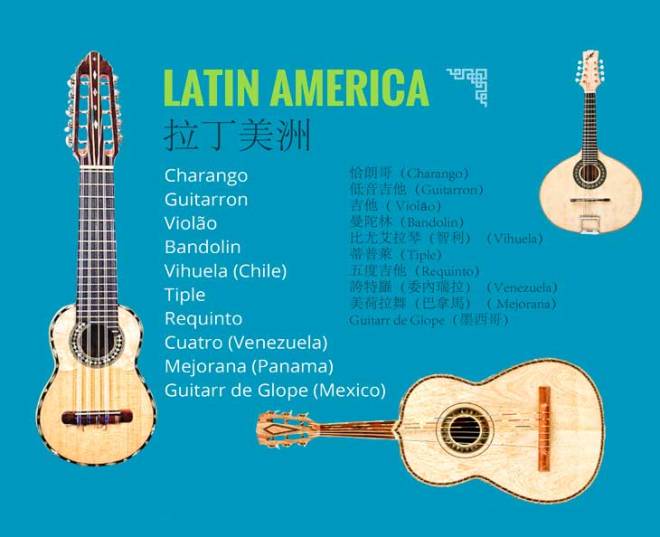In Latin America, most indigenous communities play wind and percussion instruments, with the flutes and drums being the most prominent. Thus, all the chordophones that are now prevalent in Latin America must have originated from the Iberian peninsula through the missionaries that brought the harp, violin and the guitar, from which all plucked strings had been derived. The charango or the quinquincho is an instrument common in Peru and Bolivia, having come from the Central Andean region way back in the 1700s. It is a small guitar-like instrument, with a flat or round back made of armadillo shell. In Peru, the charango’s body is sometimes carved into a mermaid which is the symbol of the power of courtship, while in Bolivia, the charango is associated with the dry season and its larger version, the guitarilla, kitara or guitarrón, is played during the rainy season. The charango may be played solo or in groups, with melodic and ostinato chordal patterns which accompany singing or dance. Together with the charango, Peru has also the mandolin, the bandurria, and the harp.

In Brazil, the popular stringed instruments are the viola (a guitar with five single or double courses of strings) which is used by the lower class, the violão (the guitar of Portugal) which is the instrument of the upper class, the cavaquinho (a small guitar similar to the ukulele), and the bandolin (a mandolin-type instrument with four double courses of strings).
In Chile, creole or mestizo music likewise originated from the Spanish church and Arab-Andalucian tradition. The instruments that were developed were the guitarra (a six-stringed guitar), the vihuela (a five-stringed guitar) and the charango which is a board zither unlike its name-sake in Bolivia and Peru. The guitarron accompanies versos, which are sung poetry. Another vocal form, the tonadas, are accompanied by one or two guitars, while in the urban areas, vocal quartets sing the tonadas, with harp, accordion and guitars.
In Columbia, the tiple is a medium size chordophone that is related to the Spanish vihuela and was seen in the country since the late 1600. The tiple today has twelve strings grouped in four courses, accompanying the voice, the bandola, as well as guitar melodies. The tiples part of estudiantinas which are organized by schools, businesses, and churches, which also include 3 bandolas and a guitar. The estudiantinas which play in serenatas in open-parks and concert halls are differentiated from murgas, which consist of non-professionals and even non-musicians, and play with tiples, clarinets, tambourines tamboras (drums), quijadas ( ) and reed flutes. In Ecuador, a small guitar called requinto is played virtuosically, and is also part of the conjuntos with 2 guitars, bombo, and raspa (gourd).
In Venezuela, there is a four-stringed guitar called cuatro which has become the national instrument. Often called guitarra in large cities, these instruments are called by the number of strings, thus, cuatro, cinco, and seis, and they play accompanying figures to the melodies of plucked lutes like the bandola and the mandolin.
In Panama, a small five-stringed guitar like the ukulele is called mejorana, the performers of which accompany singers of decimas, songs with ten lines to a stanza, as well as dances.
Since 1930s, the mariachi has become the most popular folk music ensemble in Mexico. It consists of two trumpets, 2 to 3 violins, a guitar, a guitarra de golpe, a large instrument that is between the guitar and contrabass, a harp or a string bass. Rondallas, consisting of guitars and a double bass, have also proliferated as a song-instrumental ensemble.
Next: Africa
